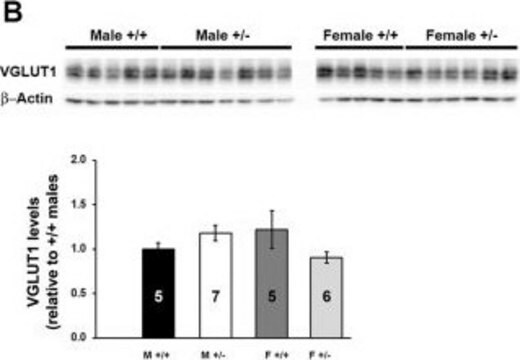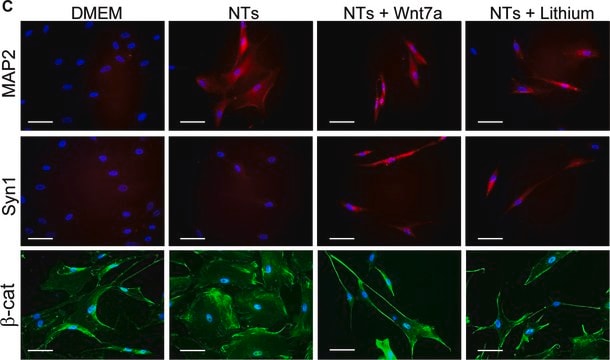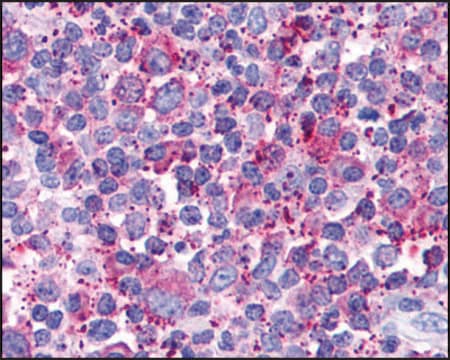AB5905
Anti-Vesicular Glutamate Transporter 1 Antibody
serum, Chemicon®
Synonym(s):
VGLUT1, BNPI
Sign Into View Organizational & Contract Pricing
All Photos(2)
About This Item
UNSPSC Code:
12352203
eCl@ss:
32160702
NACRES:
NA.41
Recommended Products
biological source
guinea pig
Quality Level
antibody form
serum
antibody product type
primary antibodies
clone
polyclonal
species reactivity
rat
manufacturer/tradename
Chemicon®
technique(s)
immunohistochemistry: suitable
NCBI accession no.
UniProt accession no.
shipped in
dry ice
target post-translational modification
unmodified
Gene Information
rat ... Slc17A7(116638)
General description
Vesicular glutamate transporter 1 (VGLUT1) is encoded by the gene mapped to human chromosome 19q13. VGLUT1 is specifically expressed in neuronal cells in the brain. It is characterized with a conserved C-terminal dileucine-like motif and two polyproline domains distal to C- terminal end, including one that binds to endocytic BAR (Bin/Amphiphysin/Rvs) domain protein, endophilin.
Specificity
Recognizes Vesicular Glutamate Transporter 1 (VGLUT1, BNPI {Brain specific Na+ dependent inorganic phosphate cotransporter}). The antiserum has been tested on tissue sections from the rat central nervous system (CNS) using immunofluorescence histochemistry. The antiserum mainly labels nerve fibers and terminals. VGLUT1 is an excellent marker for glutamatergic nerve terminals. The staining pattern for the staining obtained with the VGLUT1 antiserum corresponds to the pattern described using other antisera to VGLUT1 (Bellocchio et al., 1998; Fremeau et al., 2001; Fujiyama et al., 2001; Sakata-Haga et al., 2001; Tong et al., 2001; Kaneko et al. 2002; Varoqui et al., 2002). Preabsorption of the VGLUT1 antiserum with immunogen peptide eliminates all immunostaining.
Immunogen
Synthetic peptide from rat VGLUT1 protein with no overlap to VGLUT2. The immunogen is available as AG208.
Application
- Tested Applications
Immunocytochemistry Analysis: A 1:250 dilution from a representative lot detected Vesicular Glutamate Transporter 1 in rat E18 cortical cells. - Note: Actual optimal working dilutions must be determined by end user as specimens, and experimental conditions may vary with the end user
Target description
62 kDa
Physical form
Guinea pig Serum in 0.1% Sodium Azide.
Legal Information
CHEMICON is a registered trademark of Merck KGaA, Darmstadt, Germany
Not finding the right product?
Try our Product Selector Tool.
Storage Class Code
10 - Combustible liquids
WGK
WGK 1
Certificates of Analysis (COA)
Search for Certificates of Analysis (COA) by entering the products Lot/Batch Number. Lot and Batch Numbers can be found on a product’s label following the words ‘Lot’ or ‘Batch’.
Already Own This Product?
Find documentation for the products that you have recently purchased in the Document Library.
Customers Also Viewed
Depletion of spinal 5-HT accelerates mechanosensory recovery in the deafferented rat spinal cord
Cragg JJ, et al.
Experimental Neurology, 222(2), 277-284 (2010)
Assignment of SLC17A6 (alias DNPI), the gene encoding brain/pancreatic islet-type Na+-dependent inorganic phosphate cotransporter to human chromosome 11p14.3
Aihara Y, et al.
Cytogenetics and Cell Genetics (2001)
Xia Chen et al.
PloS one, 6(2), e17072-e17072 (2011-03-02)
The success of transplants of neural tissue into the adult dentate gyrus in generating mature neurons is highly variable. Here we address the roles of the origin of the tissue and its pre-implantation preparation, and show that both are critical.
Activation of NMDA Receptors in Lumbar Spinothalamic Cells is Required for Ejaculation.
Staudt MD, de Oliveira CV, Lehman MN, McKenna KE, Coolen LM.
Journal of Sexual Medicine null
A C Burette et al.
Neuroscience, 169(3), 987-993 (2010-08-04)
Most excitatory input in the hippocampus impinges on dendritic spines. Entry of Ca(2+) into spines through NMDA receptors can trigger a sequence of biochemical reactions leading to sustained changes in synaptic efficacy. To provide specificity, dendritic spines restrict the diffusion
Our team of scientists has experience in all areas of research including Life Science, Material Science, Chemical Synthesis, Chromatography, Analytical and many others.
Contact Technical Service











